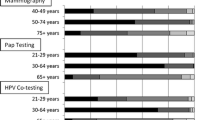Abstract
One hundred and ninety-eight primary care physicians in El Paso, Texas, were surveyed for their practices and attitudes concerning breast and cervical cancer screening. The response rate was 83%. For women 40–49 years old, 77% of respondents stated that they ordered a screening mammogram at least every two years. For women 50–74 years old, 73% said they ordered an annual screening mammogram. For women 75 years and older, 61% stated they ordered an annual screening mammogram. For women 40 years or older, 89% of respondents said they performed annual or more frequent clinical breast examinations. Eighty-four percent of respondents stated they ordered a Pap smear every 1–3 years, both for pre- and post-menopausal women. The most common reasons given for not ordering or doing a breast or cervical screening exam were patient refusal, knowledge that other doctor performs exam, high price, inadequate insurance, patient not under regular care, do not see patient for gynecologic care, and patient being seen for different reason. Seventy percent of respondents do vaginal smears on women who have had a total hysterectomy for a benign condition, and 38% use a cytobrush for endocervical sampling. Respondents were generally more comfortable with their ability to do Pap smears (72% comfortable, 1% uncomfortable) than they were in performing clinical breast examinations (52% comfortable, 4% uncomfortable). Obstetricians and gynecologists were more likely than other physicians to do vaginal smears, use a cytobrush, and feel comfortable with their Pap smear technique.
Similar content being viewed by others
References
Boring, C.C., Squires, T.S., and Tong, T. Cancer Statistics, 1993. CA Cancer J. Clin. 1993: 43:7–26
U.S. Preventive Services Task Force:Guide to clinical preventive services: an assessment of the effectiveness of 169 interventions. Williams & Wilkins, Baltimore, MD, 1989.
Rimer BK, Trock D, Engstrom PF, Lerman C, King E., Why do some women get regular mammograms?Am J Prev Med 7: 69–74, 1991.
NCI Breast Cancer Screening Consortium. Screening mammography: A missed clinical opportunity?JAMA 264:54–58, 1990.
Richardson JL, Marks G, Solis JM, Collins LM, Birba L, Hisserich JC. Frequency and adequacy of breast cancer screening among elderly hispanic women.Prev Med 16: 761–774, 1987.
Fox SA, Murata PJ, Stein JA. The impact of physician compliance on screening mammography for older women.Arch Intern Med 151: 50–56, 1991.
Fox SA, Stein JA. The effect of physician-patient communication on mammography utilization by different ethnic groups.Med Care 29: 1065–1082, 1991.
Mamon JA, Shediac MC, Crosby CB, Sanders B, Matanoski GM, Celentano DD. Inner-city women at risk for cervical cancer: Behavioral and utilization factors related to inadequate screening.Prev Med 19: 363–376, 1990.
Constanza ME, D'Orsi CJ, Greene HL, Gaw VP, Karellas A, Zapka JG. Feasibility of universal screening mammography: Lessons from a community intervention.Arch Intern Med 151: 1851–1856, 1991.
Celentano DD, Shediac MC, Crosby CC, Mamon JA, Sanders B, Matanoski M. Adequacy of cervical cancer screening among inner-city women: results from a defined population.Health Educ Res 4: 451–460, 1989.
Rimer BK, Trock B, Balshem A, Engstrom PF, Rosan J, Lerman C. Breast screening practices among primary physicians: reality and potential.JABFP 3: 26–34, 1990.
Fox SA, Klos DS, Tsou CV. Underuse of screening mammography by family physicians.Radiol 166: 431–433, 1988.
Turner BJ, Amsel Z, Lustbader E, Schwartz JS, Balshem A, Grisso JA. Breast cancer screening: effect of physician specialty, practice setting, year of medical school graduation, and sex.Am J Prev Med 8: 78–84, 1992.
Weinberger M, Saunders AF, Samsa GP, Bearon LB, Gold DT, Brown JT, Booher P, Loehrer PJ. Breast cancer screening in older women: practices and barriers reported by primary care physicians.JAGS 39: 22–29, 1991.
Author information
Authors and Affiliations
Additional information
This research was funded through grant 5 RO1 CA52977-03 from the National Cancer Institute. The Luces de Salud office at the El Paso City-County Health Department assisted with data collection.
Rights and permissions
About this article
Cite this article
Goldman, D.A., Simpson, D.M. Survey of El Paso physicians' breast and cervical cancer screening attitudes and practices. J Community Health 19, 75–85 (1994). https://doi.org/10.1007/BF02260360
Issue Date:
DOI: https://doi.org/10.1007/BF02260360




